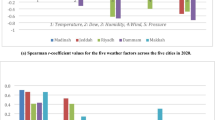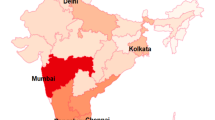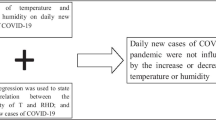Abstract
The coronavirus disease 2019 (COVID 19) turned out to be one the most substantial global crisis in the recent times. Researchers all around the world are trying to understand the factors which influence and govern the occurrence and evolution of the pandemic. Earlier understanding of diseases generated by similar family of viruses suggest that climate factors do influence the growth of disease. Similarly, the risk of natural or manmade disaster depends on the vulnerability, exposure and capacity of the population. These factors in turn depend on the socio-economic status of the exposed population. During the past few years, it has been realized that India is highly vulnerable to climate change with the existing socio-economic condition. Given the severity of COVID 19 pandemic, it becomes necessary to investigate the role of climatic factors and socio-economic conditions in augmenting the risk of the disease. This chapter discusses the role of climatic and socio-economic conditions in increasing the risk of COVID 19 pandemic. We first discuss the dependence of climatic variables in augmenting the risk of the similar diseases. Then, the role of socio-economic status of the exposed population is investigated by previous studies. Further, the chapter incorporates a case study which explores the role of four climatic variables (pressure, relative humidity, temperature and wind speed) in governing the risk of COVID 19 in India. The hazard measure in terms of the occurrence of different percentiles of confirmed COVID 19 cases was calculated and then combined with the vulnerability and exposure indicators to estimate the risks. The case study is carried out using extreme value theory in a nonstationary setting to check and incorporate the dynamic nature of climate and COVID 19 dependence.
Access this chapter
Tax calculation will be finalised at checkout
Purchases are for personal use only
Similar content being viewed by others
References
Bao J, Wang Z, Yu C, Li X (2016) The influence of temperature on mortality and its lag effect: a study in four Chinese cities with different latitudes. BMC Public Health 16:375
Coles S (2001) An introduction to statistical modeling of extreme values. Springer, London
Cui Y, Zhang Z-F, Froines J, Zhao J, Wang H, Yu S-Z, Detels R (2003) Air pollution and case fatality of SARS in the People’s republic of China: an ecologic study. Environ Health 2:15
Das J, Jha S, Goyal MK (2020a) On the relationship of climatic and monsoon teleconnections with monthly precipitation over meteorologically homogenous regions in India: wavelet & global coherence approaches. Atmos Res 238:104889
Das J, Jha S, Goyal MK (2020b) Non-stationary and copula-based approach to assess the drought characteristics encompassing climate indices over the Himalayan states in India. J Hydrol 580:124356
Dong ND, Agilan V, Jayakumar KV (2019) Bivariate flood frequency analysis of nonstationary flood characteristics. J Hydrol Eng 24:4019007. https://doi.org/10.1061/(ASCE)HE.1943-5584.0001770
Fang L, Karakiulakis G, Roth M (2020) Are patients with hypertension and diabetes mellitus at increased risk for COVID-19 infection? Lancet Respir Med 8(4):e21
Goyal MK, Ojha CSP (2012) Downscaling of precipitation on a lake basin: evaluation of rule and decision tree induction algorithms. Hydrol Res 43(3):215–230. https://doi.org/10.2166/nh.2012.040
Goyal MK, Ojha CSP (2014) Evaluation of rule and decision tree induction algorithms for generating climate change scenarios for temperature and pan evaporation on a lake basin. ASCE J Hydrol Engg 19(4):828–835. https://doi.org/10.1061/(ASCE)HE.1943-5584.0000795
Hijmans R, Nell G, Arnel R, Maunahan A, Wieczorek J, Kapoor J (2011) Global administrative areas. GADM v2 global shapefile. http://biogeo.ucdavis.edu/data/gamdm2/gadm_v2_shp.zip
Hunter J, Burke SP, Canepa A (2017) Multivariate modelling of non-stationary economic time series. Springer, Berlin
Jha S, Das J, Goyal MK (2019a) Assessment of risk and resilience of terrestrial ecosystem productivity under the influence of extreme climatic conditions over India. Sci Rep 9:1–12
Jha S, Das J, Sharma A, Hazra B, Goyal MK (2019b) Probabilistic evaluation of vegetation drought likelihood and its implications to resilience across India. Global Planet Change 176:23–35. https://doi.org/10.1016/j.gloplacha.2019.01.014
Kalnay E, Kanamitsu M, Kistler R, Collins W, Deaven D, Gandin L, Iredell M, Saha S, White G, Woollen J (1996) The NCEP/NCAR 40-year reanalysis project. Bull Am Meteorol Soc 77:437–472
Kanamitsu M, Ebisuzaki W, Woollen J, Yang SK, Hnilo JJ, Fiorino M, Potter GL (2002) NCEP-DOE AMIP-II reanalysis (R-2). Bull Am Meteorol Soc 83:1631–1643+1559. https://doi.org/10.1175/BAMS-83-11-1631(2002)083<1631:NAR>2.3.CO;2
Kugler TA, Van Riper DC, Manson SM, Haynes DA II, Donato J, Stinebaugh K (2015) Terra Populus: workflows for integrating and harmonizing geospatial population and environmental data. J Map Geogr Libr 11:180–206
Lin K, Fong DY-T, Zhu B, Karlberg J (2006) Environmental factors on the SARS epidemic: air temperature, passage of time and multiplicative effect of hospital infection. Epidemiol Infect 134:223–230
McKibbin WJ, Fernando R (2020) The global macroeconomic impacts of COVID-19: seven scenarios (March 2, 2020). CAMA Working Paper No. 19/2020. SSRN https://ssrn.com/abstract=3547729. https://doi.org/10.2139/ssrn.3547729
Nkengasong JN, Mankoula W (2020) Looming threat of COVID-19 infection in Africa: act collectively, and fast. Lancet 395:841–842
Oppenheimer M, Campos M, Warren R, Birkmann J, Luber G, O’Neill B, Takahashi K, Brklacich M, Semenov S, Licker R (2015) Emergent risks and key vulnerabilities. In: Climate change 2014 impacts, adaptation and vulnerability: part a: global and Sectoral aspects. Cambridge University Press, Cambridge, pp 1039–1100
Qu G, Li X, Hu L, Jiang G (2020) An imperative need for research on the role of environmental factors in transmission of novel coronavirus (COVID-19). Environ Sci Technol 54(7):3730–3732. https://doi.org/10.1021/acs.est.0c01102
Rawat M (2020) Coronavirus in India: tracking country’s first 50 COVID-19 cases; what numbers tell [WWW document]. India Today. https://www.indiatoday.in/india/story/coronavirus-in-india-tracking-country-s-first-50-covid-19-cases-what-numbers-tell-1654468-2020-03-12. Accessed 15 May 2020
Sachindra DA, Huang F, Barton A, Perera BJC (2014) Statistical downscaling of general circulation model outputs to precipitation-part 1: calibration and validation. Int J Climatol 34(11):3282–3303. https://doi.org/10.1002/joc.3914
Sarhadi A, Burn DH, Concepción Ausín M, Wiper MP (2016) Time-varying nonstationary multivariate risk analysis using a dynamic Bayesian copula. Water Resour Res 52:2327–2349
Sathaye J, Shukla PR, Ravindranath NH (2012) Climate change, sustainable development and India : global and national concerns. Curr Sci 90:314–325
Sharma A, Kumar GM (2018) District-level assessment of the ecohydrological resilience to hydroclimatic disturbances and its controlling factors in India. J Hydrol 564:1048–1057
Sillmann J, Kharin VV, Zhang X, Zwiers FW, Bronaugh D (2013) Climate extremes indices in the CMIP5 multimodel ensemble: part 1. Model evaluation in the present climate. J Geophys Res Atmos 118:1716–1733. https://doi.org/10.1002/jgrd.50203
Sinha J, Jha S, Goyal MK (2019) Influences of watershed characteristics on long-term annual and intra-annual water balances over India. J Hydrol 577:123970
Snell SE, Gopal S, Kaufmann RK (2000) Spatial interpolation of surface air temperatures using artificial neural networks: evaluating their use for downscaling GCMs. J Climate 13:886–895
Srivastava AK, Rajeevan M, Kshirsagar SR (2009) Development of a high resolution daily gridded temperature data set ( 1969–2005 ) for the Indian region. Atmos Sci Lett 10:249–254. https://doi.org/10.1002/asl
Wu Y, Jing W, Liu J, Ma Q, Yuan J, Wang Y, Du M, Liu M (2020) Effects of temperature and humidity on the daily new cases and new deaths of COVID-19 in 166 countries. Sci Total Environ 729:139051
Yilmaz AG, Perera BJC (2014) Extreme rainfall Nonstationarity investigation and intensity – frequency–duration relationship. J Hydrol Eng 19:1160–1172. https://doi.org/10.1061/(ASCE)HE.1943-5584.0000878
Zhang D, Hu M, Ji Q (2020) Financial markets under the global pandemic of COVID-19. Financ Res Lett:101528
Zhou F, Yu T, Du R, Fan G, Liu Y, Liu Z, Xiang J, Wang Y, Song B, Gu X (2020) Clinical course and risk factors for mortality of adult inpatients with COVID-19 in Wuhan, China: a retrospective cohort study. Lancet 395(10229):1054–1062
Zhu Y, Xie J (2020) Association between ambient temperature and COVID-19 infection in 122 cities from China. Sci Total Environ 724:138201
Author information
Authors and Affiliations
Editor information
Editors and Affiliations
Rights and permissions
Copyright information
© 2020 The Editor(s) (if applicable) and The Author(s), under exclusive license to Springer Nature Singapore Pte Ltd.
About this chapter
Cite this chapter
Jha, S., Goyal, M.K. (2020). COVID 19 Threat and the Role of Human and Natural Factors. In: Goyal, M.K., Gupta, A.K. (eds) Integrated Risk of Pandemic: Covid-19 Impacts, Resilience and Recommendations. Disaster Resilience and Green Growth. Springer, Singapore. https://doi.org/10.1007/978-981-15-7679-9_4
Download citation
DOI: https://doi.org/10.1007/978-981-15-7679-9_4
Published:
Publisher Name: Springer, Singapore
Print ISBN: 978-981-15-7678-2
Online ISBN: 978-981-15-7679-9
eBook Packages: Biomedical and Life SciencesBiomedical and Life Sciences (R0)




